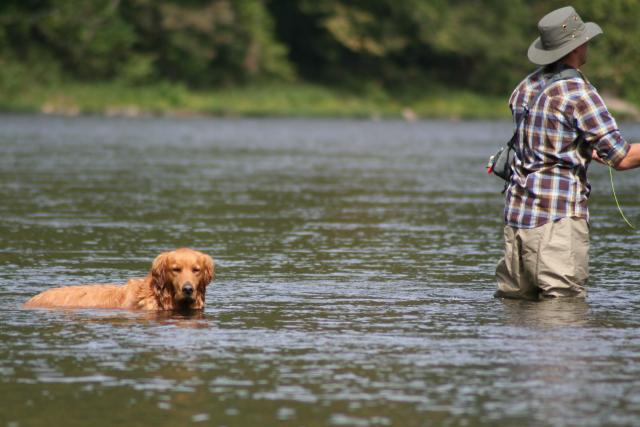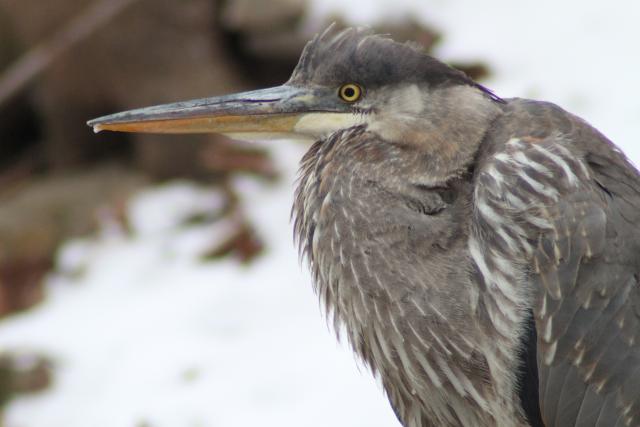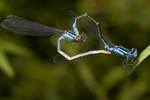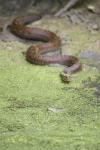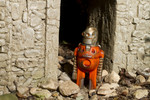Take Advantage of Situations
ktuli — Sun, 02/21/2010 - 16:40
I don't normally take photos of people. I don't know why, it just really isn't my thing. For whatever reason, I feel more comfortable tracking down a tiny little insect than I do trying to take photos of people.
On one occasion, I was out taking photos, and doing my usual thing - which in this case was chasing a butterfly. A guy and his dog wandered into the area where I was shooting. For a while I continued chasing the butterfly, but then stopped and watched as the guy began fly-fishing and his dog followed his every move. The scene started to take on the feel of a photo I'd see in a magazine.
So I decided to take advantage of the situation and step out of my comfort zone and try something new. After asking the gentleman if he minded if I took some photos, I started firing off shots.
Technical Data: Canon EOS Digital Rebel XT, Tamron 70-300mm f/4-5.6 Di LD Macro1:2 at 300m, 1/2000 sec at f/5.6, ISO 400. No post production. Cedar Creek Park, Westmoreland County, PA.
Why This Photo: I really liked the way the dog followed his owner, the scene really played out like something I thought looked like a 'classic' photo.
What Works: The eye contact with the dog provides some engagement into the scene, and I think counterbalances the fact that the fisherman is looking out of the frame. And even though you can't tell this from the photo, I think the fact that I stepped out of my comfort zone really counts for something here.
What Doesn't Work: First, this is something that bugs me a lot, yet I do it often - the horizon is not level (I've bought a bubble level to help work on this!). The framing is a bit poor, and pulling back the focal distance a bit - maybe to just 250mm would have made for a much nicer shot. Finally, the reflections are a bit distracting, I don't have a polarizing filter for this lens, but this might have been a good place for one.
The bottom line is that this isn't the greatest shot, but I took advantage of an opportunity and tried something a little new with my photography. I know that my favorite photography is macro, but I really am trying to work on expanding out into other areas, and taking advantage of a situation when it presents itself will be key to getting into that.
- Bill
Site Improvements
ktuli — Sat, 02/20/2010 - 21:45
Sorry, no photo to share tonight. I spent some time this evening fixing up a few features on the site that I've been meaning to get to since early on.
First, I fleshed out the External Links menu area in the sidebar to the right. I added links to some of the places I buy camera equipment from (or at least continually compare products and prices at) under 'Camera Stores'. I linked to The Photographic Section which seems to be Pittsburgh's main photography group which I will be officially joining this coming Tuesday. Then a section with other photography sites I visit frequently. And finally a section with links to other photographer's websites that I have been inspired by.
This is only round one of this kind of stuff, so it is by no means to be considered all inclusive or complete.
Which leads me right to the other improvement - I finally turned on the Contact form so you can send me a message any time you might have something that doesn't necessarily belong as a comment to a specific post. Anything you might have - questions, suggestions about the site, links to photography sites you think I should check out - anything except spam!
I guess that's it for now, I'm going to go relax and watch the Olympics for a bit I think... and wish I had some of the camera equipment you see scattered around the press sections at each event. Some killer nice lenses! Speaking of which - my new Sigma lens is on back-order, so it will be a bit longer till I get to play with that.
- Bill
Dragons and Depth of Field
ktuli — Thu, 02/18/2010 - 21:19
Time for another episode of "What Hangs on Our Walls at Home!"
For our first anniversary, Anya surprised me by having her parents setup a set of eight photos we had taken on the wall above my desk in our office. Each one was of a different animal from our various zoo trips (which we're hoping to resume as a hobby this spring/summer).
While the subject of this photo was something rather mundane to us at the time - after owning a pet store for about two years, Bearded Dragons aren't really anything exotic to us - what this photo lacks in an exotic subject, it makes up for two fold by being such an engaging image! In particular, by using the depth of field to its advantage.

Technical Data: Canon EOS Digital Rebel XT, Canon EF-S 18-55mm f/3.5-5.6 II at 42mm, 1/40 sec at f/5, ISO 400. No post production. National Aquarium in Baltimore, MD.
Why This Photo: I have to be honest and say that I am not 100% certain who took this photo, but the naturally curious behavior of the bearded dragon presented an obviously wonderful photo that I'm sure neither Anya nor myself could pass up.
What Works: Composition is rock solid with the dragon's face sitting perfectly on one of the hot spots for the rule of thirds. But the depth of field is what really makes this photo (I'll discuss it more below).
What Doesn't Work: The exposure in the top left of the photo is a little blown out, but somewhat offsets the dark areas in the bottom right. The focus is the tiniest bit soft (blurry) and would not work for a large print of the photo, but works just fine for the 8x12 print that hangs in the office at home.
So what is all this talk about depth of field? What the heck is depth of field, anyway?
Depth of Field is simply the amount of the photo that is focus. Perhaps some day I'll get into more about what actually causes depth of field, but today we'll talk in non-technical terms. Basically, in this photo, the head and face (and most of the beard) of the dragon is in focus. Everything else is blurred - the rocks in the background, even the dragons leg and tail that are visible. This is referred to as a shallow depth of field - when only a small portion of the photo is in focus.
Which begs the question - why would anyone want a shallow depth of field? Why wouldn't you want everything to be in focus so you could see all the details?
Well, honestly that question is one of personal preference, but in general I feel it is best used as a way to keep the viewer's attention on just the areas of the photo you have in focus. In this case, we wanted to accentuate the face of the dragon.
This can be done one of two ways. You can either completely blur the background so that nothing is recognizable or you can just blur everything that is only needed for context, but not blur it so much that it become unrecognizable.
The trick here is figuring out which to use. In this case, we want to provide the context to keep the viewer looking around this photo, but to keep coming back to the dragon's face. Since most of us know what a lizard's body looks like, the detail is not necessary in the leg and tail, but having it within the frame provides most context to make the viewer more comfortable. I guess a disembodied lizard face would be pretty discomforting to a lot of people... Or the other alternative would be a close-up of just the face of the dragon, which would not be the same kind of photo and might not be as engaging.
Instead, we use the depth of field to help direct the eyes of the viewer to the face of the bearded dragon, but because the blur is not so much that it makes things unrecognizable, the eyes of the viewer are free to wander through the rest of the photo to achieve the context of the photo.
So hopefully that helped explain a bit about why you would want to use depth of field to your advantage. I'm sure I'll have many more examples in the future, so if I did a poor job of explaining and just made you more confused, drop me a comment and let me know so I know what to do better next time.
- Bill
Shoot Favorite Local Locations
ktuli — Mon, 02/15/2010 - 21:05
I am trying to get better about this - once things warm back up again, I'll try to get back into the habit I started of carrying my camera with me full time. For now I feel the repeated heat/cold wouldn't be a good thing for the camera. Anyway...
Sometimes you don't need to travel to far off locations to get great shots. Remember - look for creative photos in what you see almost every day.
Technical Data: Canon EOS Digital Rebel XT, Canon EF-S 18-55mm f/3.5-5.6 II at 27mm, 1/250 sec at f/11, ISO 400. No post production. Mellon Arena, Pittsburgh, PA.
Why This Shot: I've always liked the architecture of the Mellon (I still like to call it the Civic) Arena. As Anya and I stood in line to get in to a game (actually on the same day we got engaged over 200 miles away in Niagara Falls), I looked up at the large steel support structure and decided I should click off a couple shots.
What Works: Strong composition of the photo seems to draw the viewers eye through the shot. The repeating patterns of the support structure and the roof tiles allow for a lot to look at in an otherwise simple composition. The bright blue sky finishes things off nicely.
What Doesn't Work: The shot is ever so slightly off level - though easily fixed with some minor rotating and cropping. The sky is just a bit over exposed, and the position of the clouds is somewhat distracting - had they been in the open area of sky, they may have been more pleasing.
This image might actually be better done as a bracketed set or HDR image to be able to gain the crisp detail in the arena and yet get the best pop out of the blue sky. Perhaps some day I'll head down there to try this one again. Though I guess I shouldn't procrastinate too too long - it will be sad to see the arena go away. It has so much character and I for one will miss the Igloo!
I hope to get to start collecting more architectural images in the future. It is an area I am interested in and so often overlook. I just need to remember what amazing photos I can get in my own backyard.
- Bill
Fun with Tele-photo Zooms
ktuli — Sun, 02/14/2010 - 21:58
Well, I finally pulled the trigger and bought a lens I've been looking at for quite some time. After tons of deliberation and waiting for our financial situation at home to cooperate, I've gone ahead and ordered what will be the largest and most expensive lens in my collection.
I'm talking about the Sigma 150-500mm f/5-6.3 DG APO OS (Optical Stabilizer) HSM AF Lens. I purchased it from Adorama Camera (they've quickly become my new favorite camera store) since they had a package deal that included a UV filter, lens cap leash (which probably won't get used), and lens cleaning kit (which will be the second one of those I'll have from them).
Anyway, back to the new toy I'm anxiously awaiting the delivery of... Let's take a moment to talk about why I selected this lens, and some of its features. The main reason for this lens was the extra reach that a 500mm lens will provide me. My main interests in photography is outdoor/nature photography and wildlife photography. The extra reach will help make a lot more shots possible.
The other major factor was price. Let's face it - at this point in time (and probably for quite a while) lenses like Sigma's $8000 "Sigmonster" are going to be way out of my price range. Canon's nearest lens is a 100-400mm lens, but still runs over $600 more. Maybe some day, but right now I have to work within my means (and even this is pushing the boundaries). Don't get me wrong, I'm sure this is still a fantastic lens worth every penny.
Once the lens comes in and I get a chance to play around with it a bit (perhaps with a trip to a zoo), I'll try and provide a bit of a review of it. Can't wait! For now, let's look at a photo from my current favorite telephoto zoom lens...
Technical Data: Canon EOS 7D, Tamron 70-300mm f/4-5.6 Di LD Macro1:2 at 300mm plus Kenko Teleplus PRO 300 "DG" AF 2x Teleconverter (I think), 1/390 sec at f/5.7, ISO Auto. No post production. Cedar Creek Park, Westmoreland County, PA.
Why This Photo: I happened upon this blue heron while wandering around Cedar Creek Park. Actually, he startled me the first time I saw him because he took flight as I hadn't noticed him and wandered fairly close to where he was, and so had to track him for a bit and sneak up on him to get close enough for this photo. I practiced approaching low and quiet and eventually managed to get to about maybe 20-25 feet from him (across a semi-frozen stream). After I was close enough, he actually allowed me to reposition fairly easily - I don't know if he was trusting me, was scared stiff, or if it was the cold that had him frozen in place.
What Works: The slow and stealthy approach coupled with a fairly long reach (600mm equivalent with the 2x teleconverter) allowed for a nice tight crop of the bird's head and shoulders. The relatively large aperture at f/5.6 provided a nicely blurred background. Focus is acceptable for the focal length and only being able to use a monopod.
What Doesn't Work: The snowy background is a bit blinding and actually produces a slightly distracting background. The exposure of the shot is a little over done and some loss of detail results - with all of the snow in the area reflecting every bit of light, I should have compensated a bit better for this by reviewing the histogram and retaking the shot. And though the focus is acceptable, it isn't perfect - the heron's eye is in focus and is fairly crisp, but looking at the feathers there is definitely some motion blur involved.
But did I mention that I ordered a new lens? And that new lens has Optical Stabilizer (Sigma's term for Image Stabilization)? I wonder just how much a feature like that might have helped this shot - though that really is no excuse for me not having my tripod with me and getting a properly focused shot.
Now... where is the UPS guy with my new lens?
- Bill
Work the Scene
ktuli — Wed, 02/10/2010 - 21:53
Something I've learned is to work a scene until you're pleased with the results. Sometimes I am better than others with maintaining the patience necessary to do this. Quite often I'm guilty of not spending quite enough time to get the shot I want, but I'm working on correcting that.
Another item is to feel free to clear up distracting elements in your shot. Most of the time with outdoor photography, this is random twigs or dead leaves. They usually take away from a shot, and a few moments makes for a much cleaner shot.
At the same time, however, one needs to weigh how much of a change you want to make to an environment - certainly I don't condone doing anything that would affect any wildlife or even the micro-environment in which you're working. As a outdoor photographer, you almost automatically have to be a conservationist.
Anyway - back to the item at hand. Working the scene.
 |
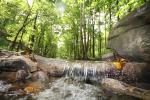 |
||
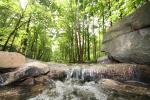
|  |
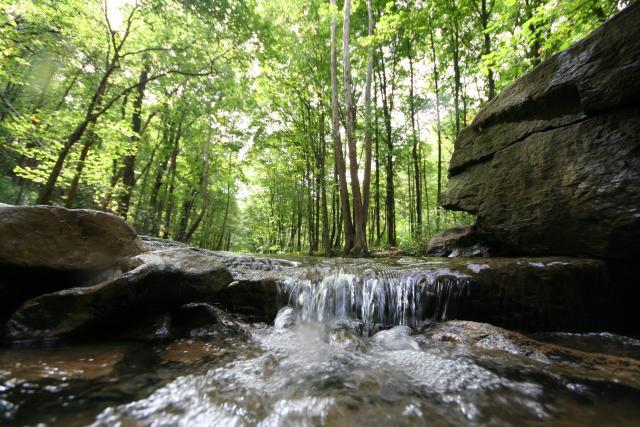
Technical Data: Canon EOS Digital Rebel XT, Sigma 10-20mm f/4-5.6 EX DC HSM AF at 10mm, 1/60 sec at f/5.6, ISO 400, No Flash. No post production. Cedar Creek Park, Westmoreland County, PA.
It is a little tough to see from each of the small photos (but you can click on them to see larger versions), but through the series of taking these photos, I went through the following changes to finally get the shot I liked most:
- Changed focal length from 20mm to 10mm
- Removed random distracting debris (dead leaves)
- Tried multiple small angle adjustments (especially leveling the horizon)
- Turned off the flash
- Took several more shots to get a favorable capture of the stream motion
The first shot is very dull and probably would have been deleted if I didn't specifically keep it as a reference to remind myself to do these kinds of things to get a more favorable shot. In the end, I have a shot that I like very much and has a much more powerful effect.
Had I not removed the dead leaves, the scene would easily be identified as a small rock in a stream - without that distracting debris, the scene looks like it could be a very large boulder instead. The removal of the flash certainly adds to that illusion of a larger subject.
I took these shots while leaning over another rock into this stream. I was not able to look into the viewfinder for any of these shots (another technique I like to use from time to time which I'll discuss some other day).
As I think back on it, it felt like I spent much longer at this spot than I really did - the timestamps of the files only differ by about two minutes. I guess this is another argument for the benefit of reviewing your photos while still out in the field. I was able to go from a poor image to a half-way decent image with a lot more character.
Whether you spent two minutes or twenty minutes or two hours, remember to try and work the scene and walk away with an image you are happy with rather than regretting not spending the extra time and having nothing else to show for it.
- Bill
Snowmageddon!
ktuli — Sat, 02/06/2010 - 22:24
So this might be a bit cliche, but I'm going to post my own Snowmageddon photos. Not going to get bogged down with critiquing or anything like that today.
So all told, I think we got about 22" worth of snow near our house. We lost power for about 12 hours. The temperature in the house had dropped all the way to 56F before the power came back and the furnace kicked back on. We were definitely happy that it did - we weren't looking to a cold night with no heat.
I headed out once in the late morning after we had shoveled the driveway partially clear, and then snapped a couple more through a window when the skies cleared and provided a bright blue sky. Enjoy.
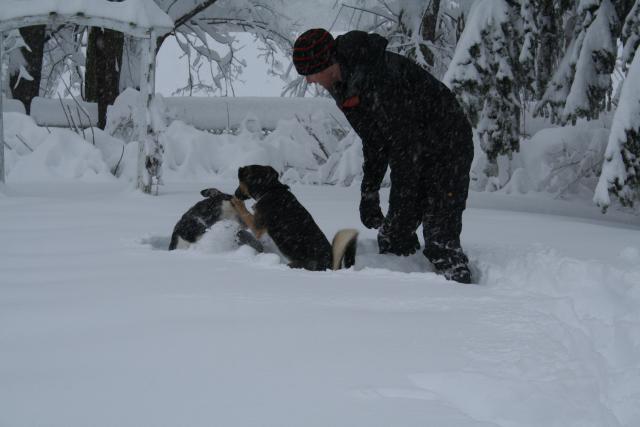
Yes - that is snow up to my knees and to the tops of our dogs' backs.
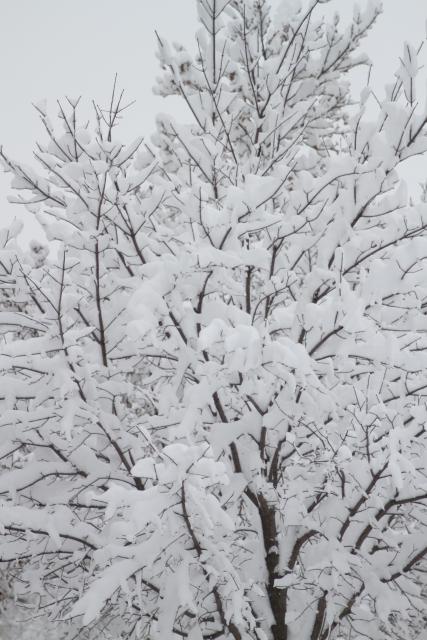
There were lots of broken branches, and with that much snow, it is no wonder.
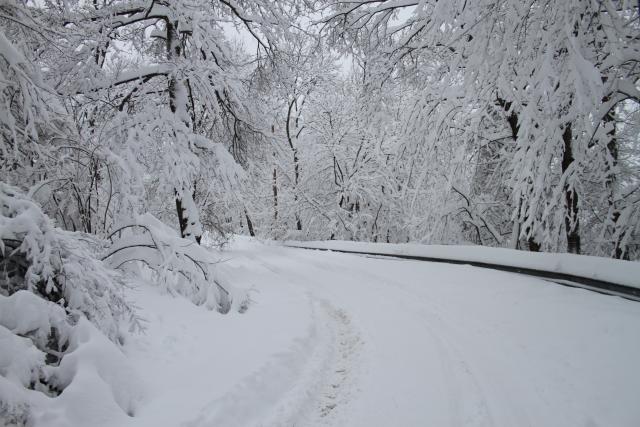
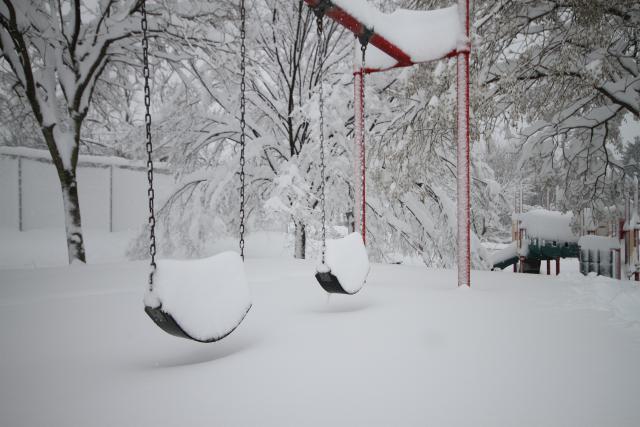
Probably hard to swing on those today...
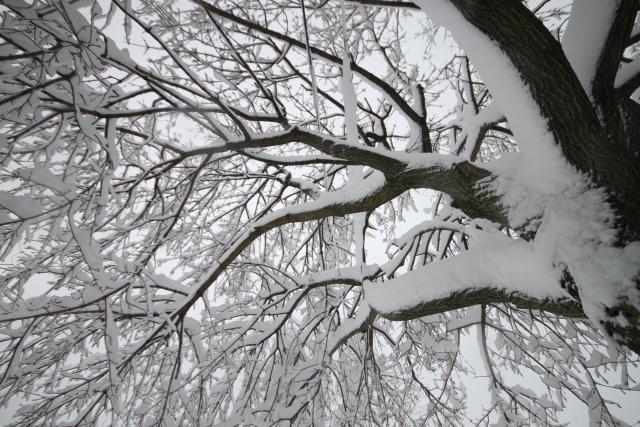
A different angle from the base of a tree
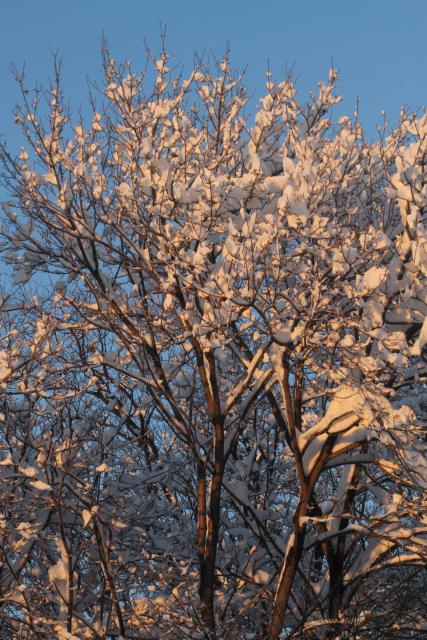
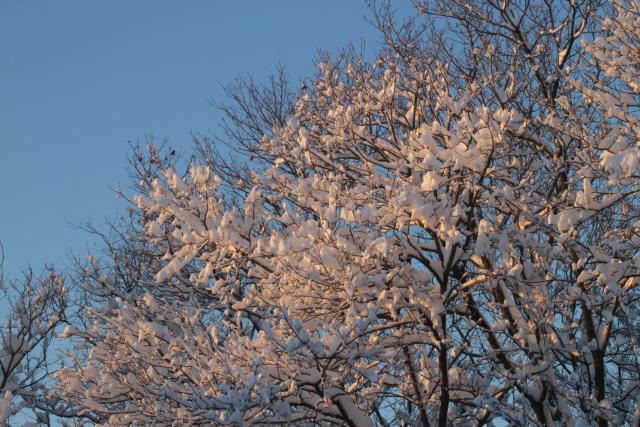
Such a beautiful blue sky!
What a day. Hopefully everyone else got their power back and are nice and warm tonight!
- Bill
A Favorite of My Own
ktuli — Thu, 02/04/2010 - 21:38
So what did everyone think of that shot that Anya took? Pretty awesome, huh?
Well, I manage to take a nice photo now and again too it seems. Today's photo just happened to come on the same trip that the previous one from Anya came from.
We spent a good two and a half hours at Phipps that day. It was the first real trip out with our new macro lens, and we really took advantage of our new toy. We ended up firing off over 120 photos, and ended up with a lot of keepers, and a handful of gems.
Our macro lens is a Tamron 180mm f/3.5 Di LD IF Macro 1:1. And if I haven't said this before, it is my favorite lens at this point in time. It is by far the largest and heaviest lens we own, but I rarely go out without it.
It really is a fantastic lens. The price tag is definitely such that it makes is reasonable - I like Canon equipment and all, but this lens ends up being half the cost of the equivalent Canon lens. It comes with a case, a lens hood, and a tripod mount.
Construction of the lens is rock solid, and I've never had it give me the slightest problem. Sometimes the auto-focus takes a little while to seek, but not having used any other macro lenses, it might be normal, and I'm not sure how loud or quiet it is compared to other macro lenses. For a 1:1 macro lens, I think you would be hard pressed not to pick this lens.
Technical Data: Canon EOS Digital Rebel XT, Tamron 180mm f/3.5 Di SP LD 1:1 Macro, 1/500 sec at f/5.6. ISO 100. No post production. Phipps Conservatory, Pittsburgh, PA.
Why This Photo: We were wandering outside of Phipps and were taking many photos of the various lilies there. After a number of different angles and shots, I managed this shot with the near perfect reflection.
What Works: Composition and depth of field are spot on. The focus is tack sharp right where it needs to be.
What Doesn't Work: The exposure in the reflection is a bit blown out, producing a large area that is very bright and somewhat distracting. Perhaps with a ND filter to be able to tone down the bottom half of the photo, this would have worked better.
This photo is also printed, framed, and hanging in our house. And I like to look at it and be inspired by my own work. Hopefully this is just one of many photos I'll take that I'll want framed and hanging on my wall.
- Bill
Shutter Envy
ktuli — Wed, 02/03/2010 - 21:48
This photo was taken by my wife, Anya. It is one of my all time favorite photos.
I thought maybe I should wait a little longer to use this one, but I just couldn't wait.

Technical Data: Canon EOS Digital Rebel XT, Tamron 180mm f/3.5 Di SP LD 1:1 Macro, 1/500 sec at f/7.1. ISO 250. No post production. Phipps Conservatory, Pittsburgh, PA.
Why This Photo: I can't really say why Anya took this photo, but I'm really glad that she did. Like I said, it is one of my all time favorites!
What Works: Almost everything. The composition is rock solid, the depth of field is perfect. I know this was taken outdoors in some pretty bright sunlight, and the way the light plays across the flower is mesmerizing.
What Doesn't Work: The focal plane is just a smidge close. It looks like it focused just a tiny bit before the main part of the flower. But I also know that this shot was taken handheld, and I'm really stretching to be able to find something "wrong" with this photo.
We have this photo printed and framed in our house. I've used it as my wallpaper on my computer and cell phone.
I don't think I'll ever get tired of looking at this photo. And each time I look at it, I remember all the great photo trips Anya and I go on and look forward to the next one (which should be coming up here soon for my birthday).
It is shots like this that make me think that we should sell prints. What do you think? Would you pay for a framed copy of this photo?
- Bill
Poll: Flash or No Flash?
ktuli — Sat, 01/30/2010 - 20:26
Yet another style of post to try out today...
Sometimes, I try multiple settings for a photograph and then when I get home I either forget to delete the lesser quality shots or as is more often the case, debate which version is better. Sometimes I'll have multiple versions of a photo that I like each version for various reasons.
That's where you come in - from time to time, I'll post those multiple versions and leave it open to a vote as to which version is the best.
Today's photo set was done as easily as using the flash for one shot and not using the flash for the other.

Flash Version Technical Data: Canon EOS Digital Rebel XT, Canon EF 80-200mm f/4.5-5.6 II at 89mm, 1/60 sec at f/4.5. ISO 400. Flash Auto. No Post Production. Near Frisco Pier, Cape Hatteras, NC.

No Flash Version Technical Data: Canon EOS Digital Rebel XT, Canon EF 80-200mm f/4.5-5.6 II at 89mm, 1/13 sec at f/4.5. ISO 400. Flash Off. No Post Production. Near Frisco Pier, Cape Hatteras, NC.
Honestly, I'm torn! I can't decide which version I like better. What about you?
Cast your vote, leave some comments to back up your vote!
- Bill

